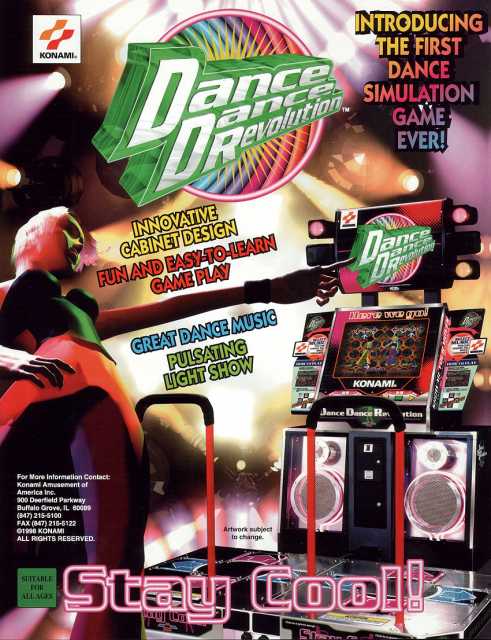Releases
Dance Dance Revolution (DDR) was originally released as a Japanese arcade machine in November 1998. Following the release of the Japan-only DDR 2ndMix arcade machine, DDR was released to other regions in March 1999 containing a mixture of songs from the two editions. Releases in Asia and the US were identically titled, but the European machine was branded as Dancing Stage. The original machine is commonly referred to as DDR 1stMix in keeping with the naming scheme of subsequent releases. Except for a very small selection of special releases (DDR USA, Dancing Stage EuroMix, etc.) this was the only DDR arcade machine released outside of Asia until the muti-region arcade release of DDR SuperNOVA.
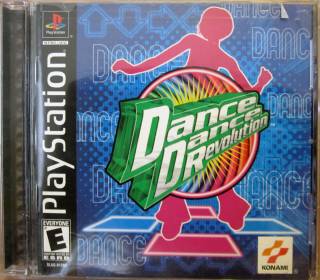
April 1999 saw the Japanese home release on the Playstation featuring additional songs and enhanced gameplay. The game was packaged with a thin foam pad very similar to recent DDR releases. Home versions were not released outside of Japan until May 2001. By that point there were many home and arcade versions available in Japan on Playstation including a major release DDR 3rdMix. The US and European releases included a selection of songs from across the existing Japanese versions as well as the gameplay enhancements introduced since the first arcade release.
Hardware
Arcade
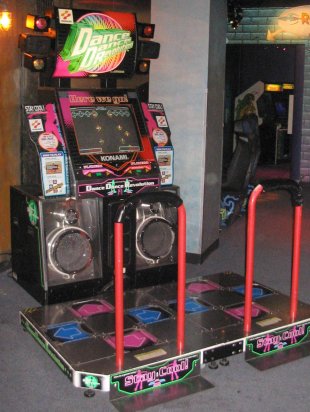
The arcade machine features a wide raised metal stage for two players to stand on while playing. Each player has a set of four recessed pads (up, down, left, and right) which are stepped on in coordination to the arrows displayed on the screen. Each pad has lights underneath which illuminate when activated. A railing behind each player protects from a loss of balance while playing.
The base of the machine contains large speakers surrounded by neon lights and the top has colored spotlights aimed at the player both of which flash in coordinated patterns during gameplay. Buttons on the face of the machine are used to navigate menus and select songs.
Playing in arcades was a social event. Because machines were frequently located in movie theaters and in malls, people would often gather around the player to watch them. Often, people standing behind the player would play the game as well, stepping on imaginary dance pads. Competitive play was quite rewarding, because of the social element.
Console
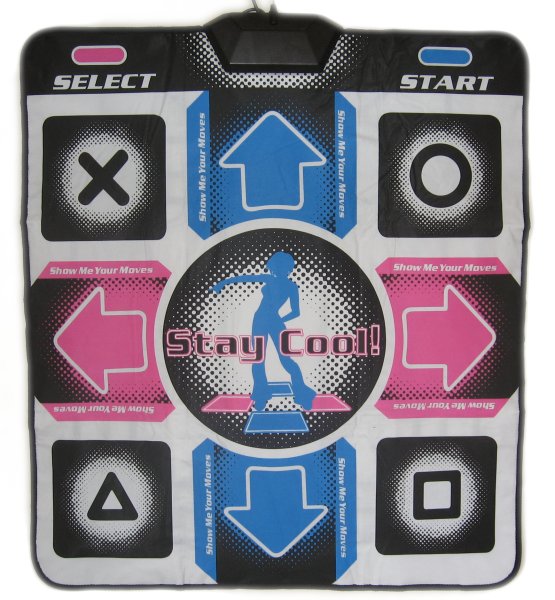
The pads provided with the home edition are similar to the Power Pad. They feature a thin foam matting covered by a plastic top layer with the pressure sensors sandwiched between the two layers. Small Start and Select buttons are positioned at the top of the pad and the diagonal spaces are used for the traditional Playstation face buttons (X, circle, square, and triangle). The pad is used for both the gameplay and menu navigation.
Common complaints about the foam pads often stem from the fact that one must look down at the pad to assure that they still have their feet aligned with the sensors when the recessed pads on the arcade version do not present this problem. Another common problem with home pads is "traveling", where pads shift across the floor during play due to poor traction. In addition, the thin mat failed quickly when used with shoes, yet provided little padding when playing on hard floors, making barefoot and sock play an uncomfortable alternative.
Because of widespread dissatisfaction with the foam dance pads, 3rd party dance pad controllers were sought out by players. The more expensive pads allowed for more precise inputs and ranged from slightly thicker foam pads to heavy duty metal pads mimicking the construction of the arcade machine. Notably, RedOctane sold a popular line of DDR pads before becoming the official controller manufacturer for Guitar Hero.
Gameplay
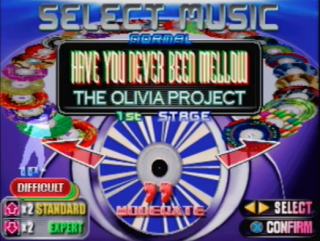
As the first game in the series, the gameplay was much simpler than recent DDR games. The only elements of gameplay present were the scrolling notes and life meter. On harder difficulties notes could come two at a time, asking the player to jump to hit both simultaneously. A single "credit" allows 3 songs to be played.
Different difficulty songs had different steps. The higher the player pushed themselves, the higher their score. Players could also select their dancing avatar from a very limited list. In later DDR releases, the avatars would become official Konami characters, and would appear from game to game.
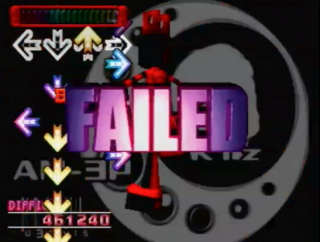
Successfully timing footsteps to the arrows adds to a life meter. Missing the timing significantly will subtract from it. The player's steps are graded in the accuracy of their timing from "perfect" to "miss." Anything lower than a rating of "good" on a step would break the combo chain, lowering the player's score multiplier.
If the life bar ever reaches empty, the player fails and play of that song ends immediately. At the end of a song, the player is given a summary of their performance and a letter grade in addition to the score earned, ranging from F to SS.
Playstation Release
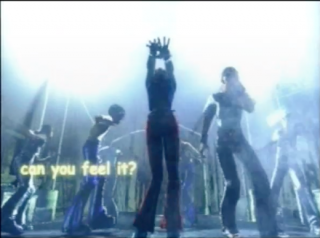
The console release of Dance Dance Revolution could be said to be the beginning of the mainstreaming of dance games (or the even the wider genre of music games) in the United States market. Fans had been clamoring for the game for almost three years. The widespread success of the game would ensure almost a dozen sequels on the Playstation platform alone.
The game could only be purchased with a bundled dance mat for under $100, though later entries in the franchise could be purchased with the game alone. The mat came with rubber stickers to help it to adhere to the floor and prevent "drifting" during gameplay.

The gameplay is surprisingly simplistic when compared to modern Dance Dance Revolution games. Many of the more complex moves are simply not present, such as cross directional combinations like Up and Left, or Down and Right. Triplet note steps (three consecutive 8th note steps) are only present on the hardest difficulty.
The songs of the PS1 release are a mix of multiple games from Japan, although all very short and heavily compressed. The default song is "Have you never been Mellow," by the Olivia Project. The game features none of the hidden songs or other unlockables which would become a staple of later home releases.
New Dance Modes
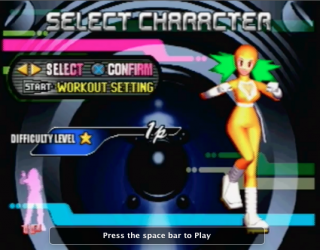
The Playstation release of the game came with three alternate dance modes which would become staples of almost every subsequent DDR game.
Workout mode was included to market the game as a fitness activity. Interestingly, there are no female dancing avatars present in the "Arcade" mode of the game. But, in workout mode, where the goal is to burn as many calories as possible, the default dancing model is a more voluptuous dancer.
Gamespot reviewer Ryan Davis noted of the new workout mode, "It's a weird addition, and the calorie count is highly questionable." Even on the easiest modes, the game may report that over 100 calories were burned by playing through several songs. Players could create their own workout mixes, and enter their weight in kilograms.
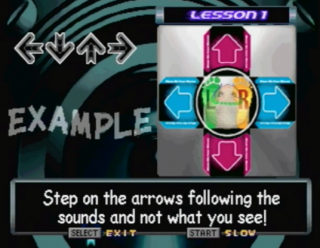
Dance Dance Revolution also featured a "Lesson mode" set to an urban drum beat with rap vocals. It explained the basics of the game, such as stepping on panels to the beat, and simple jumping combinations like Left and Right, or Up and Down. When mastered, players would get a crown icon added next to the level. Unfortunately, the mode was so simple compared to the other modes of the game that it was not helpful as anything more than a primer. As later entries in the franchise added more complex gameplay, they also included more complex lesson sequences. A new lowest difficulty level of "Easy" was also added to later entries which not only included simpler step patterns, but also replaced the usual background animations with a dancer avatar on a standard DDR mat following along with required dance steps as the song played.
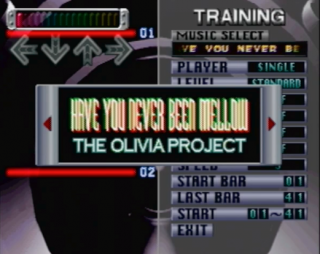
Training mode was probably the most helpful addition to the home release. Players could choose any song in the game and practice it with various tools to help them learn the steps. A song could be slowed down, difficult sections of songs could be isolated and practiced, and a metronome could be set.
This feature was less important for the original DDR, but would become much more important in subsequent releases of the game, as the difficulty increased. Later additions of Dance Dance Revolution would add various types of quest modes, rewarding players with new songs for playing as higher and higher difficulties.
Reception
The home version of DDR was well received in the United States, despite the long delay in its arrival. Gamespot reviewer Ryan Davis gave in an 8.3 noting, "Dance Dance Revolution is a great introduction to a truly unique series, with incredibly addictive gameplay. The soundtrack will have you humming for days."
IGN reviewer David Smith gave the game a very high score of 9.3, but was more impatient at the timing. "At long last, Dance Dance Revolution is here. What is there left to say, exactly?" He went on to unabashedly praise the game. "I love Dance Dance Revolution. I think it's just about the best game to ever hit arcades or a home system." He added, "I have some pretty frickin' big problems with the North American song list, but I absolutely recommend this to American players."
Soundtrack
Each release of the game in different formats and regions tweaked and expanded the list of available songs. A relative latecomer, the North American Playstation release boasts a mixture of songs from both the original and later arcade releases 2ndMix and 3rdMix.
Arcade (Japan)
| Song Title | Artist |
|---|---|
| Butterfly | Smile.dk |
| Have You Never Been Mellow | The Olivia Project |
| Kung Fu Fighting | Bus★Stop featuring Carl Douglas |
| Let's Get Down | JT Playaz |
| Little Bitch | The Specials |
| Make It Better | Mitsu-O! Summer |
| My Fire | X-Treme |
| Paranoia | 180 |
| Strictly Business | Mantronik vs EPMD |
| That's the Way (I Like It) | KC & The Sunshine Band |
| Trip Machine | De-Sire |
Playstation (Japan)
| Song Title | Artist |
|---|---|
| Boys | Smile.dk |
| Butterfly | Smile.dk |
| Have You Never Been Mellow | The Olivia Project |
| I Believe in Miracles | Hi-Rise |
| Kung Fu Fighting | Bus★Stop featuring Carl Douglas |
| Let's Get Down | JT Playaz |
| Little Bitch | The Specials |
| Make a Jam! | U1 |
| Make It Better | Mitsu-O! Summer |
| My Fire | X-Treme |
| Paranoia | 180 |
| Paranoia KCET ~Clean Mix~ | 2MB |
| Paranoia Max ~Dirty Mix~ | 190 |
| Strictly Business | Mantronik vs EPMD |
| That's the Way (I Like It) | KC & The Sunshine Band |
| Trip Machine | De-Sire |
Arcade (Asia)
| Song Title | Artist |
|---|---|
| AM-3P | KTz |
| Brilliant2U | NAOKI |
| Brilliant2U (Orchestra-Groov) | NAOKI |
| Butterfly | Snile.dk |
| Have You Never Been Mellow | The Olivia Project |
| Make It Better | Mitsu-O! Summer |
| Make It Better (So-Real Mix) | Mitsu-O! Summer |
| My Fire | X-Treme |
| Paranoia | 180 |
| Put Your Faith In Me | Uzi-Lay |
| Put Your Faith In Me (Jazz Groov) | Uzi-Lay |
| Strictly Business | Manronik vs EPMD |
| Trip Machine | De-Sire |
Arcade (US & Europe)
| Song Title | Artist |
|---|---|
| AM-3P | KTz |
| Boom Boom Dollar | King Kong & D. Jangle Girls |
| Brilliant2U | NAOKI |
| Brilliant2U (Orchestra-Groov) | NAOKI |
| Butterfly | Smile.dk |
| Have You Never Been Mellow | The Olivia Project |
| Make It Better | Mitsu-O! |
| Make It Better (So-Real Mix) | Mitsu-O! Summer |
| My Fire | X-Treme |
| Paranoia | 180 |
| Put Your Faith In Me | Uzi-Lay |
| Put Your Faith In Me (Jazz Groov) | Uzi-Lay |
| Trip Machine | De-Sire |
Europe v2 (Sept 1999 arcade re-release)
| Song Title | Artist |
|---|---|
| AM-3P | KTz |
| Boom Boom Dollar | King Kong & D. Jangle Girls |
| Brilliant2U | NAOKI |
| Brilliant2U (Orchestra-Groov) | NAOKI |
| Butterfly | Smile.dk |
| Have You Never Been Mellow | The Olivia Project |
| It's Like That | Run DMC vs Jason Nevins |
| Last Thing On My Mind | Steps |
| Make It Better | Mitsu-O! |
| Make It Better (So-Real Mix) | Mitsu-O! Summer |
| My Fire | X-Treme |
| Paranoia | 180 |
| Put Your Faith In Me | Uzi-Lay |
| Put Your Faith In Me (Jazz Groov) | Uzi-Lay |
| Trip Machine | De-Sire |
| Uh La La La | Alexia |
Playstation (US)
| Song Title | Artist |
|---|---|
| 20, November (DDR Version) | N.M.R. |
| Afronova | RE-VENGE |
| AM-3P | KTz |
| Boom Boom Dollar | King Kong & D. Jangle Girls |
| Brilliant2U | NAOKI |
| Brilliant2U (Orchestra-Groov) | NAOKI |
| Drop the Bomb | Scotty D. |
| Dub-I-Dub | Me & My |
| Dynamite Rave | NAOKI |
| El Ritmo Tropical | Dixies Gang |
| Get Up'n Move | S&K |
| Have You Never Been Mellow | The Olivia Project |
| I Believe In Miracles | Hi-Rise |
| If You Were Here | Jennifer |
| Keep On Movin' | N.M.R. |
| La Senorita | Captain. T |
| Let Them Move | N.M.R. |
| Make It Better | Mitsu-O! |
| My Fire (UKS Remix) | X-Treme |
| Paranoia | 180 |
| Paranoia (KCET Clean Mix) | 2MB |
| Paranoia Max (Dirty Mix) | 190 |
| Put Your Faith In Me | Uzi-Lay |
| Put Your Faith In Me (Jazz Groov) | Uzi-Lay |
| Smoke | Mr. Ed Jumps the Gun |
| SP-Trip Machine (Jungle Mix) | De-Sire |
| Trip Machine | De-Sire |

 PlayStation
PlayStation Arcade
Arcade PC
PC









